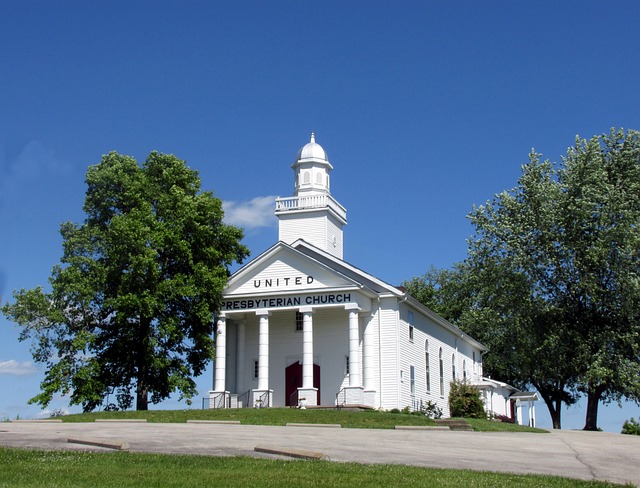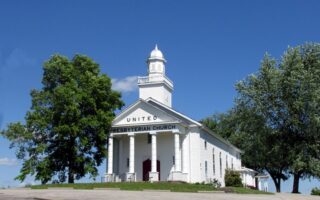Presbyterians typically do not kneel to pray as it is not a common practice within their tradition.
Table of Contents
The Significance of Kneeling in Presbyterian Worship
Do Presbyterians kneel to pray? This is a question that often comes up when discussing Presbyterian worship practices. While kneeling is not a common posture for prayer in Presbyterian churches, it is not entirely absent either. The significance of kneeling in Presbyterian worship is worth exploring, as it sheds light on the broader understanding of prayer and worship in this tradition.
In many Christian denominations, kneeling is a common posture for prayer. It is seen as a sign of humility and reverence before God. However, in Presbyterian worship, the emphasis is often placed on the inward disposition of the heart rather than the physical posture. Presbyterians believe that prayer is a conversation with God, and the focus is on the sincerity and authenticity of the prayers offered.
That being said, there are instances where Presbyterians do kneel during worship. One such occasion is during the sacrament of the Lord’s Supper, also known as Communion. In Presbyterian churches, it is common for the congregation to come forward and kneel at the communion table to receive the bread and wine. This act of kneeling is seen as a way to express gratitude and reverence for the sacrifice of Christ.
Another instance where kneeling may be observed is during special services or times of corporate prayer. While not a regular practice, some Presbyterian churches may incorporate kneeling into their worship services on certain occasions. This can be seen as a way to physically express the deep sense of awe and surrender before God.
It is important to note that the absence of kneeling in Presbyterian worship does not diminish the significance of prayer. Presbyterians believe that prayer can be offered in any posture, whether standing, sitting, or even lying down. The focus is on the heart’s attitude and the sincerity of the prayers offered.
The emphasis on the inward disposition of the heart in Presbyterian worship is rooted in the Reformed tradition. The Protestant Reformation, which gave birth to Presbyterianism, sought to reform the church by placing a greater emphasis on the authority of Scripture and the individual’s direct relationship with God. This emphasis on the heart’s attitude in prayer aligns with the Reformed understanding of the priesthood of all believers.
In Presbyterian worship, the congregation is seen as a community of believers, each with their own unique relationship with God. The act of prayer is not limited to the clergy or a select few, but is open to all members of the congregation. This egalitarian approach to prayer is reflected in the absence of prescribed physical postures, such as kneeling.
In conclusion, while kneeling is not a common posture for prayer in Presbyterian worship, it is not entirely absent either. The emphasis in Presbyterian worship is on the inward disposition of the heart rather than the physical posture. Kneeling may be observed during the sacrament of the Lord’s Supper or during special services, but it is not a regular practice. Presbyterians believe that prayer can be offered in any posture, and the focus is on the sincerity and authenticity of the prayers offered.
Understanding Presbyterian Prayer Practices: Kneeling vs. Standing

Do Presbyterians kneel to pray? This is a common question that many people have when it comes to understanding Presbyterian prayer practices. The answer, however, is not as straightforward as one might think. While kneeling is not a common practice among Presbyterians, it is not completely unheard of either.
In Presbyterian churches, the act of prayer is seen as a personal and intimate conversation with God. It is a time for individuals to express their thoughts, concerns, and gratitude to the Almighty. Unlike some other Christian denominations, Presbyterians do not believe that there is a specific physical posture that one must assume in order to pray effectively. Instead, they believe that the posture of the heart is what truly matters.
That being said, standing is the most common posture for prayer among Presbyterians. When individuals gather for worship, they typically stand together as a congregation to pray. This practice is rooted in the belief that standing signifies a posture of reverence and respect. By standing, Presbyterians are acknowledging the presence of God and showing their willingness to listen and respond to His guidance.
While standing is the norm, there are instances where Presbyterians may choose to kneel during prayer. This is often seen during more solemn occasions, such as during a time of confession or during a special service. Kneeling is seen as a way to humble oneself before God and to acknowledge one’s own sinfulness. It is a physical expression of contrition and a desire for forgiveness.
However, it is important to note that kneeling is not a requirement in Presbyterian worship. It is a personal choice that individuals may make based on their own spiritual convictions. Some Presbyterians may feel called to kneel during prayer, while others may feel more comfortable standing. Ultimately, the decision is left up to the individual and their personal relationship with God.
In recent years, there has been a shift in Presbyterian worship practices. Many churches have adopted a more informal and relaxed approach to worship, which has led to a decrease in the use of kneeling during prayer. This change reflects a desire to create a more inclusive and welcoming environment for all worshippers, regardless of their physical abilities or personal preferences.
In conclusion, while kneeling is not a common practice among Presbyterians, it is not completely absent from their worship. Standing is the most common posture for prayer, as it signifies reverence and respect. However, there are instances where individuals may choose to kneel as a way to express humility and contrition. Ultimately, the decision of whether to kneel or stand during prayer is a personal one, based on individual spiritual convictions and preferences.
Exploring the Historical Roots of Kneeling in Presbyterian Tradition
Do Presbyterians kneel to pray? This is a question that has often been asked, and the answer may surprise you. While kneeling is not a common practice among Presbyterians today, it does have historical roots in the tradition.
To understand the historical significance of kneeling in Presbyterian tradition, we need to go back to the early days of the church. In the early centuries of Christianity, kneeling was a common posture for prayer. It was seen as a sign of humility and reverence before God. This practice was carried on by the early reformers, including John Calvin, who believed in the importance of showing reverence in worship.
However, as the Reformation progressed, there was a shift in the understanding of worship. The reformers emphasized the priesthood of all believers and the direct access to God through Christ. This led to a simplification of worship practices, including a move away from elaborate rituals and postures. Kneeling, along with other physical gestures, was seen as unnecessary and even potentially distracting from the true focus of worship.
As a result, many Protestant churches, including Presbyterians, moved away from kneeling as a regular practice in worship. Instead, the emphasis was placed on the inward attitude of the heart rather than outward physical postures. This shift was also influenced by the desire to distance themselves from what was seen as the excessive ritualism of the Roman Catholic Church.
However, it is important to note that while kneeling may not be a common practice in Presbyterian worship today, it is not completely absent. There are still occasions when Presbyterians may choose to kneel in prayer. For example, during times of personal confession or during special services such as Good Friday, when the focus is on the solemnity of Christ’s sacrifice.
Furthermore, individual Presbyterians may choose to kneel in private prayer as a personal expression of reverence and humility before God. This is a matter of personal preference and conviction, rather than a requirement of the tradition.
In recent years, there has been a renewed interest in the practice of kneeling in worship among some Presbyterian churches. This has been driven by a desire to recapture a sense of reverence and awe in worship, as well as a recognition of the historical roots of the tradition. Some churches have introduced opportunities for kneeling during certain parts of the worship service, while others have made it optional for individuals.
Ultimately, whether or not Presbyterians kneel to pray is a matter of personal and congregational preference. The tradition does not prescribe a specific posture for prayer, but rather emphasizes the inward attitude of the heart. Whether one chooses to kneel, stand, or sit, the most important thing is the sincerity and reverence with which one approaches God in prayer.
So, the next time you find yourself in a Presbyterian worship service, don’t be surprised if you don’t see many people kneeling. While the tradition may have moved away from this practice, it is still rooted in a rich history that values reverence and humility before God.
Debunking Misconceptions: Do All Presbyterians Kneel to Pray?
Do Presbyterians kneel to pray? This is a common question that many people have, and the answer may surprise you. While it is true that some Christian denominations, such as Catholics, often kneel during prayer, this is not a universal practice among all Christians. In fact, Presbyterians have a different approach to prayer that does not involve kneeling.
Presbyterians are a Protestant denomination that originated in Scotland in the 16th century. They follow the teachings of John Calvin and believe in the sovereignty of God and the authority of Scripture. When it comes to prayer, Presbyterians have a more informal and personal approach.
Unlike some other Christian denominations, Presbyterians do not have a set posture for prayer. They believe that prayer is a conversation with God and can be done in any position that is comfortable for the individual. Some Presbyterians may choose to kneel during prayer, but it is not a requirement or a common practice within the denomination.
Instead of focusing on physical posture, Presbyterians place more emphasis on the content and sincerity of their prayers. They believe that prayer is a way to communicate with God and seek His guidance, comfort, and forgiveness. It is a time to express gratitude, share concerns, and ask for help. Presbyterians believe that God listens to their prayers regardless of their physical position.
In Presbyterian churches, you will often find people praying in various ways. Some may choose to sit quietly with their eyes closed, while others may stand with their hands raised. Some may even walk around as they pray. The important thing is that they are connecting with God and expressing their thoughts and feelings to Him.
It is worth noting that while Presbyterians do not have a specific posture for prayer, they do have certain traditions and practices that are associated with worship. For example, during a Presbyterian worship service, you may see people standing to sing hymns or sitting to listen to the sermon. These practices are part of the order of worship and are separate from personal prayer.
So, if you ever find yourself in a Presbyterian church and wonder whether you should kneel to pray, rest assured that it is not necessary. Presbyterians believe that prayer is a personal and individual act, and the physical position is not as important as the heart and intention behind the prayer.
In conclusion, Presbyterians do not kneel to pray as a general practice. While some individuals may choose to kneel during prayer, it is not a requirement or a common tradition within the denomination. Presbyterians believe that prayer is a conversation with God and can be done in any position that is comfortable for the individual. The focus is on the content and sincerity of the prayer, rather than the physical posture. So, the next time you encounter a Presbyterian praying, remember that they are connecting with God in their own unique way.
Conclusion
No, Presbyterians do not typically kneel to pray.


